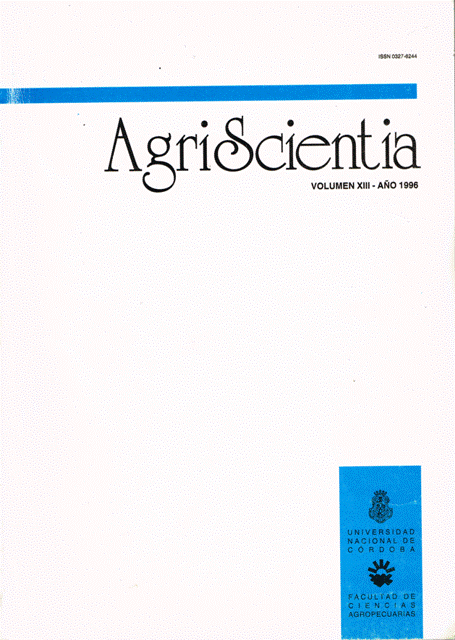Biology of Acrosternum bellum Rolston, 1983 (Hemiptera, Pentatomidae)
Main Article Content
Abstract
Studies on the biology of Acrosternum bellum Rolston, 1983, were carried out under laboratory conditions (Temperature = 24.6 ± 0.7 °C, Relative Humidity = 60.4 ± 4%; Photoperiod = 16 h light). Insects were fed with fresh fruits of Phaseolus vulgaris (L.). Mean time from oviposition to adult was 38.5 days. Cumulative mortality reached 74.5%, with the greatest mortality occurring in the second nymphal instar. The sex ratio of adults reared in the laboratory was 1.3 females: 1 male. Mean fecundity was 6.9 egg masses per female with an average of 13.9 eggs per mass. Adult longevity averaged 73.3 days. No significant differences (P > 0.01) were observed between sexes. Compared with other species of Acrosternum, such as A. armigera (Stal), A. hilare (Say), A. apicicorne (Spinola), and A. marginatum (Palisot de Beauvois), studied under similar conditions, A. bellum had a shorter cycle of development and higher nymphal mortality. Adult longevity and biotic potential were higher than in A. marginatum and shorter than in A. apicicorne.
Article Details

This work is licensed under a Creative Commons Attribution-ShareAlike 4.0 International License.
How to Cite
References
Decoursey, R. M., & Allen, R. C. (1968). A generic key to the nymphs of the Pentatomidae of the Eastern United States (Hemiptera: Heteroptera). The University of Connecticut Occasional Papers (Biological Science Series), 1(3), 141–151.
Esselbaugh, C. O. (1946). A study of the eggs of the Pentatomidae (Hemiptera). Annals of the Entomological Society of America, 39, 667–691.
Grazia, J., Del Vechio, M. C., & Hildebrand, R. (1982). Estudos das ninfas de pentatomídeos (Heteroptera) que vivem sobre soja [Glycine max (L.) Merrill]: IV - Acrosternum impicticorne (Stal, 1872). Anales de la Sociedad Entomológica de Brasil, 11, 261–268.
Hallman, G. J., Morales, C. G., & Duque, M. C. (1992). Biology of Acrosternum marginatum (Heteroptera: Pentatomidae) on common beans. Florida Entomologist, 75(2), 190–196.
La Porta, N., & Avalos, S. (1993). Aspectos biológicos de Acrosternum apicicorne (Spinola, 1862) (Hemiptera: Pentatomidae). AGRISCIENTIA, X, 45–49.
Liljesthrom, G. (1983). Algunos aspectos de la demografía de Nezara vindula (L.) (Hemiptera: Pentatomidae) en condiciones de laboratorio. Revista de la Sociedad Entomológica Argentina, 42(1-4), 383–396.
Rabinovich, J. (1980). Introducción a la ecología de las poblaciones animales. CECSA.
Rolston, H. L. (1983). A revision of the genus Acrosternum Fieber, subgenus Chinavia Orian, in the Western Hemisphere (Hemiptera: Pentatomidae). Journal of the New York Entomological Society, 91(2), 97–176.
Saini, E. D. (1984). Identificación de los huevos de pentatómidos (Heteroptera) encontrados en cultivos de solanáceas. IDIA, 425(4), 79–84.
Saini, E. D. (1989). Clave para la identificación de las ninfas de pentatómidos encontrados en cultivos de solanáceas. Revista de la Sociedad Entomológica Argentina, 46(1-4), 129–139.
Simmons, A. M., & Yeargan, K. V. (1988). Development and survivorship of the green stink bug, Acrosternum hilare (Hemiptera: Pentatomidae), on soybean. Environmental Entomology, 17(3), 527–532.
Sokal, R., & Rohlf, J. (1969). Biometría: Principios y métodos estadísticos en la investigación biológica. H. Blume Ediciones. 186-192.





